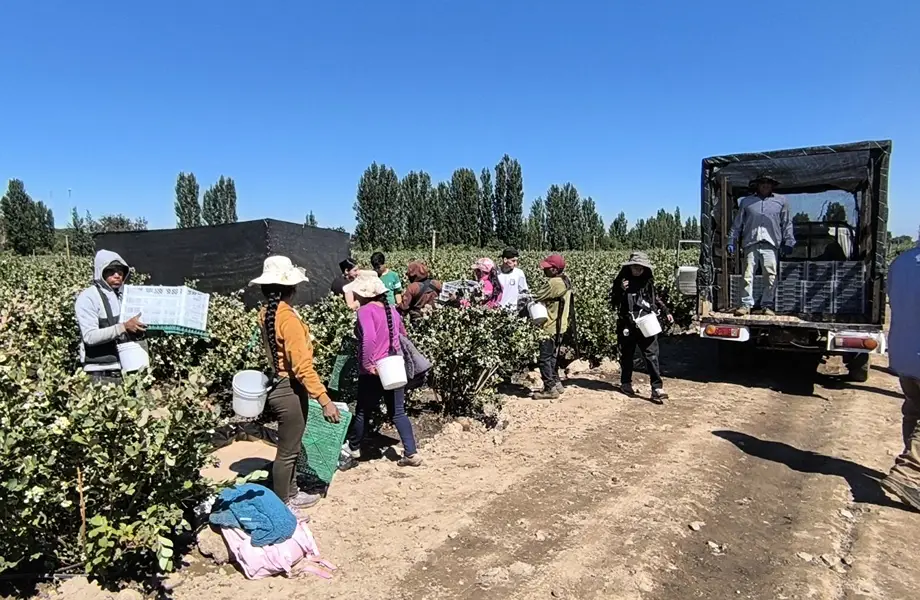The past campaign represented a real shock for the blueberry sector, developing in a completely unexpected way. This was due to changes introduced by the El Niño phenomenon in Peruvian production. The world had become accustomed to seeing Peru as a reliable supplier, capable of delivering increasing quantities of fruit to northern markets every year.
The Past Campaign: A Shock for the Blueberry Sector
In 2023, however, this was not the case. Due to this phenomenon, the harvests in the first part of the campaign abruptly decreased, with Peru exporting 40% less than the previous year. This drop and the unpredictability caused two issues. The forecasts had to be revised weekly.
This explains why the sector is starting the new campaign with a certain uncertainty and apprehension. Will the market be able to predict moments of shortage or oversupply? Is it necessary to look for more than one supplier to ensure a consistent fruit supply?
Peru
Fortunately, the weather has normalized. A cold winter was recorded, even colder than expected. The crops are recovering, but there is a significant delay in maturation, as pruning occurred a few weeks later than usual due to El Niño.
The new campaign started in May, but with small quantities that gradually increased. By mid-August, more than 12,000 tons had been exported, 40% less than in 2023 and less than half compared to 2022.
The slow pace will continue through the end of August and September. Only by the end of September will shipments return to normal.
A larger volume of supply is expected for October and November, with quantities exceeding those of 2023. A good shipping pace is also expected for the final months of the campaign (from December to February), similar to the previous season.
Therefore, it will be a late campaign, but with good volume. This is due to the recovery of the plantations, but also to new cultivated areas.
The transition to new genetics will intensify. Among the varieties gaining importance are Rocio, Sekoya, Eureka Sunrise, Magic, Kestrel, Madeira, etc.
Ventura, despite being an excellent variety and the second most cultivated after Biloxi, suffered a setback in 2023 due to the lack of cold. Everything indicates that Ventura might also be affected by lower temperatures this year.
When evaluating the varieties, attention is also paid to their behavior in response to climate change; a characteristic in which Ventura is not the best.
At the moment, it is difficult to make a total export volume estimate. Experts, after last year's unpredictable forecasts and ongoing climate changes, are cautious.
However, everyone indicates that the 226,000 tons projected for 2023/24 will be exceeded. Whether the 286,000 tons from 2022/23 will be reached or even a new record of 300,000 tons will be set remains to be seen.
Chile
For Chile, too, the past season was not normal. On the one hand, the negative trend in exports was interrupted. A further decline was predicted following the reduction in acreage and the varietal change, but this did not happen.
Exports amounted to 86,000 tons, a volume similar to the previous season. Northern markets were also more interested in Chile, as the uncertainty of Peruvian supplies showed that it was too risky to rely on a single supplier.
The best prices paid in 2023/24, especially in the first half of the campaign, restored some of the profitability that the harvest had lost. Several producers who were unsure whether to exit the market decided to stay.
However, not everything was positive in the last campaign.
In the second half of the year, the business deteriorated due to the large supply and qualities that did not meet market requirements. This experience prompted Chilean associations to intensify their efforts to demand quality and limit varieties, continuing their quality control program introduced a few years ago.
It is still too early to provide an estimate. Most of the crops are dormant. The propagation cycle has only started in the earliest regions.
This winter was cold enough. Additionally, there was sufficient rainfall, improving the water balance and partially replenishing water reservoirs, many of which were in critical condition.
South Africa
In recent years, the blueberry sector in South Africa has been a success, recording steady growth.
However, the 2023/24 season was particular. The growth trend in exports suffered a setback. Due to climate issues, South Africa could not take advantage of the excellent timing for southern suppliers.
Exports started late and remained below the previous year's levels. The 2023/24 season ended with a total shipment of 21,000 tons, 12% less than in 2022/23.
The prospects for the new season are positive, and production and export recovery is expected. This year's winter was cold, ensuring a sufficient number of chill hours.
Rains also came at the right time, crucial in a country with many water restrictions.
The crops are well-loaded, and the fruits have adequate quality. Harvesting has begun in the earliest regions, but quantities are still low at the moment. The first shipments have been made, aiming to maintain a similar pace to 2023.
Argentina
After years of deteriorating exports and loss of competitiveness due to internal problems and growing external competition, the 2023/24 campaign was a relief.
The fact that the Argentine campaign coincided with the Peruvian one, the big problem of past years, turned out to be an advantage this time. Northern markets did not have enough Peruvian fruit, so they looked back to Argentina.
6,300 tons were exported, a 50% increase compared to 2022, but still far from the levels of a few years ago. It is not possible to increase the exportable quantity overnight.
This year there was a cold winter with several intense frosts. Most plantations have frost protection, but the protection is not always sufficient. Therefore, a 10%-15% loss in early varieties is expected.
The campaign started two weeks late and is developing more slowly than in previous years, as the weather is still cool. It is estimated that shipments will pick up speed starting in September. A campaign similar to 2023, with a possible slight increase, has been forecast.
Source: Ing. Agr. Betina Ernst - Fruchthandel
Image by tawatchai07 on Freepik










